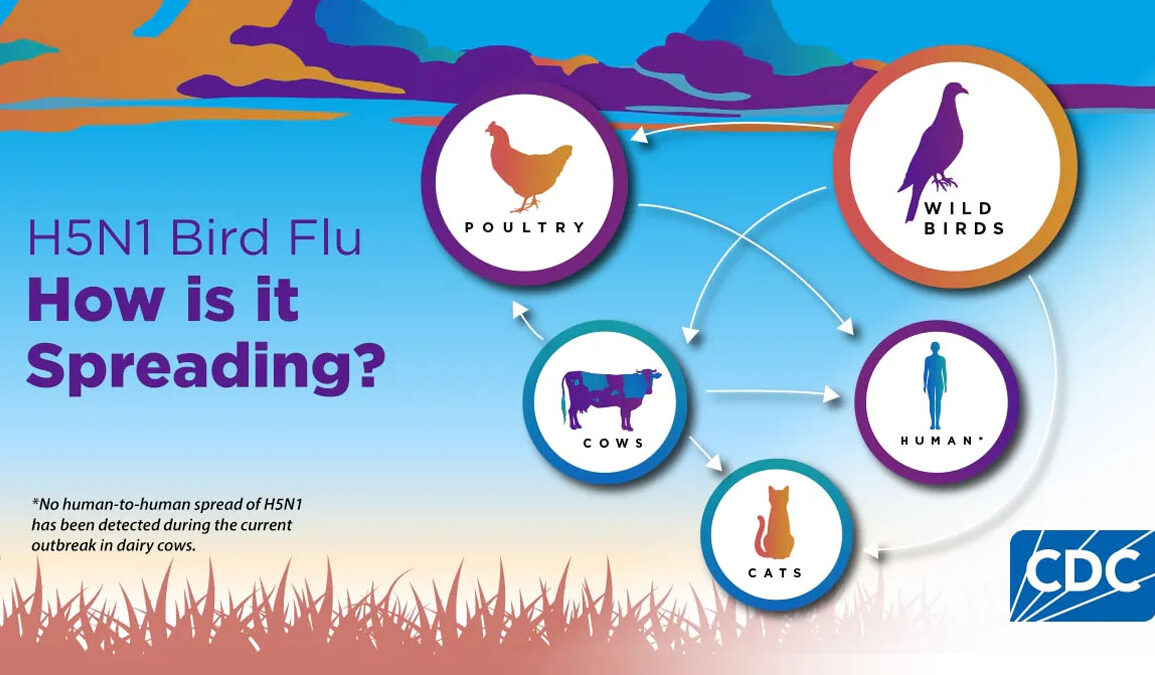The bird flu, or H5N1 virus, has surged into the national spotlight as it spreads rapidly across animal populations and raises concerns about its potential impact on humans. Experts warn that the virus’s unchecked movement through dairy cattle, poultry, and even pets could set the stage for a larger health crisis.
Where is Bird Flu Spreading in the U.S.?
The H5N1 virus has been detected in dairy cow herds across 16 states, with human cases reported in California, Colorado, Michigan, Texas, Washington, and Louisiana. Outbreaks are not limited to cows—wild birds, poultry flocks, and even domestic pets have been infected. Wastewater testing reveals that the virus’s presence extends beyond farm animals, painting a concerning picture of its reach.
NBC News’ Evan Bush reported, “Since April, at least 65 people have tested positive for the virus—the first U.S. cases other than a single infection in 2022. Dairy cow herds in 16 states have been infected this year. The Centers for Disease Control and Prevention confirmed the country’s first severe bird flu infection on (last) Wednesday, a critically ill patient in Louisiana.”
Governor Gavin Newsom of California declared a state of emergency in response to widespread outbreaks in cows and poultry, underscoring the gravity of the situation.
How Fast is Bird Flu Spreading?
Since March 2024, the virus has spread extensively in dairy cattle, wild birds, and mammals. Human infections remain rare but are increasing, with at least 66 confirmed cases in the U.S. this year. Experts worry that the virus is evolving, becoming better equipped to infect human receptors. While human-to-human transmission has not been documented, the virus’s rapid adaptation raises red flags.
Dr. Peter Chin-Hong, an infectious disease expert at the University of California, San Francisco, described the situation with a metaphor: “The traffic light is changing from green to amber. So many signs are going in the wrong direction.”
Furthermore, wastewater surveillance indicates the virus’s genetic material is spreading widely, suggesting potential unseen hotspots of infection.
How Does Bird Flu Affect Animals?
The virus primarily targets birds but has shown an ability to infect mammals, including cows and pets. Infected cows often suffer from severe udder infections, which compromise milk production. Cats have also been infected, with at least one confirmed death linked to contaminated raw milk. In one recent case, “a voluntary recall was issued for a line of raw and frozen pet food after a cat died of bird flu,” according to NBC News.
The economic toll is significant, with millions of birds culled and rising concerns about dairy product safety. Nick Vyas from the USC Marshall School of Business explained, “It’s poised to disrupt supply chains, particularly in the poultry industry, leading to higher prices and possible shortages of poultry products.”
Is Bird Flu Dangerous for Humans?
The Centers for Disease Control and Prevention (CDC) maintains that the current risk to public health is low. Most human infections have occurred in people directly exposed to infected animals, such as farm workers. However, the virus’s potential to mutate and spread between humans remains a significant concern. Symptoms in humans range from mild eye irritation to severe respiratory illness, with one recent critically ill patient reported in Louisiana.
Amy Maxmen from KFF Health News pointed out the slow response from federal agencies, saying, “It’s disheartening to see so many of the same failures that emerged during the COVID-19 crisis reemerge.”
What is the CDC Doing?
The CDC is actively monitoring H5N1 through flu surveillance systems and coordinating with state health departments. They are analyzing viral genetic sequences, testing milk supplies, and offering guidance to farmers and veterinarians. The agency is also working to ensure preparedness in case of a broader outbreak.
However, experts like Tom Bollyky from the Council on Foreign Relations have criticized the government’s slow response: “A sluggish response to emerging outbreaks may simply be a new, unfortunate norm for America. If so, the nation has gotten lucky that the bird flu still can’t spread easily between people.”
CDC’s Protective Actions: How to Stay Safe
The CDC recommends the following steps to reduce the risk of bird flu exposure:
- Avoid Direct Contact with Wild Birds: Observe from a distance and avoid handling sick or dead birds.
- Report Sick or Dead Birds: Notify local authorities about unusual bird deaths.
- Avoid Unprotected Exposure to Infected Animals: Use protective gear when working with livestock or poultry.
- Avoid Raw Milk and Dairy Products: Always consume pasteurized milk and dairy products.
- Cook Eggs and Poultry Thoroughly: Ensure poultry and eggs are cooked to safe internal temperatures.
- Wear Protective Equipment on Farms: Use goggles, disposable gloves, N95 masks, coveralls, and rubber boots when working with potentially infected animals.
- Practice Good Hygiene: Wash hands thoroughly after animal contact.
- Get a Seasonal Flu Vaccine: This reduces the risk of co-infection with human and bird flu viruses.
- Monitor Symptoms After Exposure: Seek medical attention if you experience flu-like symptoms after animal exposure.
- Stay Informed: Follow updates from the CDC and local health authorities.
The Bottom Line
While the immediate risk to the general public remains low, the bird flu outbreak underscores vulnerabilities in our food supply and public health infrastructure. Increased surveillance, better collaboration between agencies, and adherence to safety guidelines will be critical in preventing the virus from becoming the next pandemic. For now, vigilance and proper precautions remain our best defense against H5N1.
As Dr. Chin-Hong warns, “This is not a time for complacency. The virus is showing us warning signs, and we must act swiftly to prevent further escalation.”








